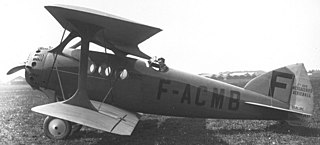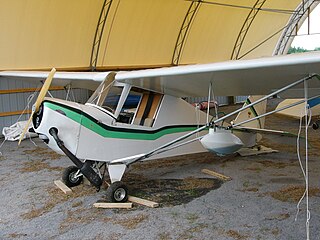
The Piper PA-24 Comanche is an American four-seat or six-seat, low-wing, all-metal, light aircraft of semimonocoque construction with tricycle retractable landing gear. Piper Aircraft designed and developed the Comanche, which first flew on May 24, 1956. Together with the PA-30 and PA-39 Twin Comanches, it made up the core of the Piper Aircraft lineup until the production lines for both aircraft were destroyed in the 1972 Lock Haven flood.

Aerocar International's Aerocar was an American roadable aircraft designed and built by Moulton Taylor in Longview, Washington in 1949. Although six examples were made, it never entered large-scale production. It is considered one of the first practical flying cars.

The Aerocar II Aero-Plane was an unusual light aircraft flown in the United States in 1964. It was developed from designer Moulton Taylor's Aerocar roadable aircraft, but could not be driven as a road vehicle. It used the wings and tail designed for the Aerocar, with a new fibreglass cabin. Excluding the parts needed for road operation allowed two more passengers to be carried. Only a single example was built.

The Aerocar Mini-IMP is a light aircraft designed by Moulton Taylor and marketed for homebuilding by Aerocar International. It is a scaled-down derivative of his original Aerocar IMP design. A two-seat version called the Bullet was also built. The Mini-IMP follows the same unconventional layout as its larger predecessor, with a center mounted engine, long driveshaft to a tail propeller, and inverted-V rudder/elevators.
The Aerocar Micro-IMP was a light sportsplane developed from the successful Mini-IMP homebuilt. Designed by Moulton Taylor and Jerry Holcomb in 1978, it was finished in 1981 and demonstrated at Oshkosh the following year.

The Dornier Do 214 was a proposed large long-range flying boat, developed by Dornier in World War II.

The Nord Aviation 3202 was a 1950s French military trainer aircraft designed and built by Nord Aviation to meet a French Army requirement for a two-seat basic trainer, as a replacement for the biplane Stampe SV.4. Altogether, 101 examples were built, with the first flying on 17 April 1957.

The Blackburn R.B.2 Sydney was a long-range maritime patrol flying boat developed for the Royal Air Force in 1930, in response to Air Ministry Specification R.5/27. It was a parasol-winged braced monoplane of typical flying boat arrangement with triple tailfins and its three engines arranged on the wing's leading edge. After evaluation, it was not ordered into production and no further examples were built.

The Bleriot-SPAD S.33 was a small French airliner developed soon after World War I. The aircraft was a biplane of conventional configuration whose design owed much to the Blériot company's contemporary fighter designs such as the S.20. Four passengers could be accommodated in an enclosed cabin within the monocoque fuselage, and a fifth passenger could ride in the open cockpit beside the pilot. A great success, the S.33 dominated its field throughout the 1920s, initially on CMA's Paris-London route, and later on continental routes serviced by Franco-Roumaine.

The AS/SA 202 Bravo is a two to three-seat civil light aircraft jointly designed and manufactured by the Swiss company Flug- und Fahrzeugwerke Altenrhein (FFA) and the Italian company Savoia-Marchetti. The aircraft was designated the AS 202 in Switzerland, and the SA 202 in Italy.

The Fisher FP-101 is an American single-seat, high-wing, conventional landing gear, tractor configuration single engine ultralight aircraft that was available in kit form from Lite Flite of South Webster, Ohio and later Fisher Flying Products of Edgeley, North Dakota.

The Convair Model 118 ConvAirCar was a prototype flying car of which two were built. Intended for mainstream consumers, two prototypes were built and flown. The first prototype was lost in an accident due to fuel exhaustion. Subsequently, the second prototype was rebuilt from the damaged aircraft and flown. By that time, little enthusiasm remained for the project and the program ended shortly thereafter.
The Star Flight Starfire is the first aircraft in a large family of American ultralight aircraft that was designed by Dick Turner and produced by Star Flight Manufacturing, introduced in 1979. The aircraft were all supplied as kits for amateur construction.

The Pilatus PC-8D Twin Porter was a Swiss ten-seat light transport built by Pilatus Aircraft. The type did not go into production and only one was built.

The Flylight Motorfloater is a British ultralight trike, designed by Ben Ashman and produced by Flylight Airsports of Northamptonshire. The aircraft is supplied as a complete ready-to-fly-aircraft.
The Midwest Questar XLS is an American ultralight aircraft that was designed and produced by Midwest Engineering of Overland Park, Kansas. When it was available the aircraft was supplied in the form of plans for amateur construction, but the plans were withdrawn on 29 June 2000.
The Stewart S-51D Mustang is an American aerobatic homebuilt aircraft that was designed by Jim Stewart and produced by Stewart 51 of Vero Beach, Florida, introduced in 1994. When it was available the aircraft was supplied as a kit for amateur construction.
The Phoenix Industries CV1 ParaFlyer is an American powered parachute that was designed and produced by Phoenix Industries of Southampton, New Jersey. Now out of production, when it was available the aircraft was supplied as a complete ready-to-fly-aircraft.
The Trixy Trixformer is an Austrian roadable aircraft autogyro/electric motorcycle designed and produced by Trixy Aviation Products of Dornbirn, introduced in 2014. The vehicle is supplied complete and ready-to-fly.
The CAMS 90 was an amphibious observation flying boat built in the early 1930s. The wings were made of wood, but the hull was of all-metal construction. The Lorraine Mizar engine was mounted in a pusher configuration.












